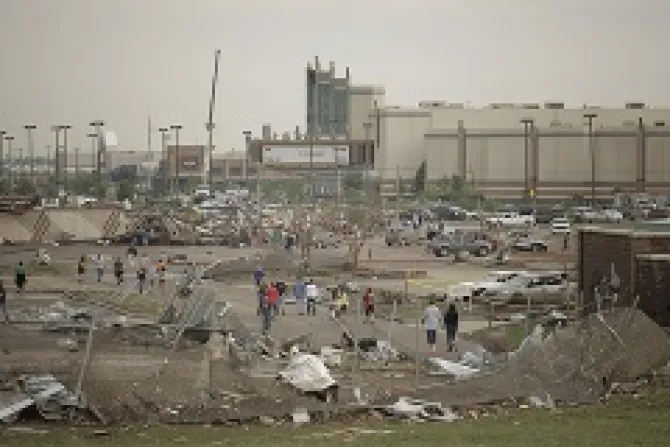Oklahoma City, Okla., May 21, 2013 / 14:15 pm
Archbishop Paul S. Coakley of Oklahoma City traveled to Moore today to give his support and concern to those devastated by the tornado that swept through the town yesterday, May 20.
"I feel, as the archbishop, as a shepherd, I need to be there," Archbishop Coakley told CNA while on his way to the suburb of Oklahoma City on May 21.
"I'm not sure…there's anything very practical I can do when I arrive, other than to show my pastoral concern and support, and give the assurance of my prayers to those who are indeed suffering."
He added that "people are in such shock right now, we just want to accompany them in their suffering at this point."
The tornado, which was two miles wide at its greatest, touched down mid-afternoon yesterday, and lashed the area for 45 minutes with winds of up to 200 mph. It destroyed homes, businesses, the local hospital and other buildings, including Plaza Towers Elementary School.
Officials have reported 24 dead, including nine children. Earlier reports of as many as 91 deaths were attributed to the double-reporting of some corpses.
The archbishop said that he and Catholic Charities of Oklahoma City will be assessing the needs of the situation. "We're organizing to provide immediate relief as well as long-term assistance in terms of people beginning to rebuild their lives, their homes."
"We want to be available to provide ordinary pastoral care under the extraordinary situations." He reported that the city's parish was undamaged, "so as soon as they have power and water restored in the parish, they can continue providing pastoral care to those who are in the area."
He called the situation in Moore "hectic" and "chaotic," and said that "at this point we're still in the process of assessing needs, is probably the most honest thing I could say."
The archdiocesan Catholic Charities will focus on long-term response to the tornado, offering case management and counseling, he said.
William Banowsky, the agency's development director, told CNA that they are setting up a plan, coordinating with state, federal and local agencies "to work together on a cohesive plan."
He said Catholic Charities "works with those affected long-term, so we're there for their immediate needs, finding shelter and clothing and things like that, but we work with them for up to three, four years, however long it takes for them to get back on their feet."
Archbishop Coakley said, "what I'm suggesting to people who are wanting to do something immediately, is to go to the Catholic Charities of Oklahoma City website (http://catholiccharitiesok.org/), and they can donate online for the tornado disaster relief, and that will go completely to assist the victims."
"And pray, please…we urge them to pray, to be mindful of the suffering individuals and families, and community of central Oklahoma."
Archbishop Coakley said he's been "overwhelmed" by the support and prayers of those from across the country and the world, and that Oklahomans are "mindful and very grateful for that."
Tina Dzurisin, archdiocesan communications director, said that the prayers and warm wishes the community has received from the world-wide Church have been "really encouraging and uplifting, even in a time of tragedy."
The archbishop also expressed gratitude to the first responders in Moore, many of whom have been there for 24 hours now, "who are really to be admired and appreciated. They are giving their all, and we want to remember them in our prayers, because they're dealing with some very difficult situations on the ground, there's terrible human suffering they're having to deal with, and they're doing it beautifully."
Carson Krittenbrink, a seminarian of the Oklahoma City archdiocese who has been to Moore to assist those in need, said there are "police, firemen, and ambulance workers everywhere" in the city, and the National Guard is present.
He told CNA that there are injured people all over Moore. At least 200 were injured in the tornado.
Krittenbrink has family in Moore, and their home has "a big hole in the roof" and "it ripped brick off the side of house, broke every window in the house."
That damage, however, was a "glancing blow" from the tornado. "The houses just across the street are clean to the foundation, nothing left."
While going with his parents to help their relatives, Krittenbrink said, "we were running over powerlines, we were having to skirt chunks of roof in the road."
A long-time resident of Oklahoma, Krittenbrink said this is "the worst tornado damage I've ever seen."
The storm did damage proper to the strongest category of tornado, EF-5, and may be the areas worst tornado seen in some 30 years.



